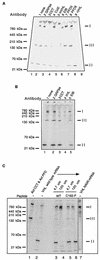Diverse effects of mutations in exon II of the von Hippel-Lindau (VHL) tumor suppressor gene on the interaction of pVHL with the cytosolic chaperonin and pVHL-dependent ubiquitin ligase activity
- PMID: 11865071
- PMCID: PMC135590
- DOI: 10.1128/MCB.22.6.1947-1960.2002
Diverse effects of mutations in exon II of the von Hippel-Lindau (VHL) tumor suppressor gene on the interaction of pVHL with the cytosolic chaperonin and pVHL-dependent ubiquitin ligase activity
Abstract
We examined the biogenesis of the von Hippel-Lindau (VHL) tumor suppressor protein (pVHL) in vitro and in vivo. pVHL formed a complex with the cytosolic chaperonin containing TCP-1 (CCT or TRiC) en route to assembly with elongin B/C and the subsequent formation of the VCB-Cul2 ubiquitin ligase. Blocking the interaction of pVHL with elongin B/C resulted in accumulation of pVHL within the CCT complex. pVHL present in purified VHL-CCT complexes, when added to rabbit reticulocyte lysate, proceeded to form VCB and VCB-Cul2. Thus, CCT likely functions, at least in part, by retaining VHL chains pending the availability of elongin B/C for final folding and/or assembly. Tumor-associated mutations within exon II of the VHL syndrome had diverse effects upon the stability and/or function of pVHL-containing complexes. First, a pVHL mutant lacking the entire region encoded by exon II did not bind to CCT and yet could still assemble into complexes with elongin B/C and elongin B/C-Cul2. Second, a number of tumor-derived missense mutations in exon II did not decrease CCT binding, and most had no detectable effect upon VCB-Cul2 assembly. Many exon II mutants, however, were found to be defective in the binding to and subsequent ubiquitination of hypoxia-inducible factor 1alpha (HIF-1alpha), a substrate of the VCB-Cul2 ubiquitin ligase. We conclude that the selection pressure to mutate VHL exon II during tumorigenesis does not relate to loss of CCT binding but may reflect quantitative or qualitative defects in HIF binding and/or in pVHL-dependent ubiquitin ligase activity.
Figures









Similar articles
-
The Hsp70 and TRiC/CCT chaperone systems cooperate in vivo to assemble the von Hippel-Lindau tumor suppressor complex.Mol Cell Biol. 2003 May;23(9):3141-51. doi: 10.1128/MCB.23.9.3141-3151.2003. Mol Cell Biol. 2003. PMID: 12697815 Free PMC article.
-
The pVHL-associated SCF ubiquitin ligase complex: molecular genetic analysis of elongin B and C, Rbx1 and HIF-1alpha in renal cell carcinoma.Oncogene. 2001 Aug 16;20(36):5067-74. doi: 10.1038/sj.onc.1204602. Oncogene. 2001. PMID: 11526493
-
Contrasting effects on HIF-1alpha regulation by disease-causing pVHL mutations correlate with patterns of tumourigenesis in von Hippel-Lindau disease.Hum Mol Genet. 2001 May 1;10(10):1029-38. doi: 10.1093/hmg/10.10.1029. Hum Mol Genet. 2001. PMID: 11331613
-
The von Hippel-Lindau tumor suppressor protein.Curr Opin Genet Dev. 2001 Feb;11(1):27-34. doi: 10.1016/s0959-437x(00)00152-0. Curr Opin Genet Dev. 2001. PMID: 11163147 Review.
-
The role of von Hippel-Lindau tumor suppressor protein and hypoxia in renal clear cell carcinoma.Am J Physiol Renal Physiol. 2004 Jul;287(1):F1-6. doi: 10.1152/ajprenal.00424.2003. Am J Physiol Renal Physiol. 2004. PMID: 15180922 Review.
Cited by
-
VEGF-targeted therapy in renal cell carcinoma: active drugs and active choices.Curr Oncol Rep. 2006 Mar;8(2):85-9. doi: 10.1007/s11912-006-0041-5. Curr Oncol Rep. 2006. PMID: 16507216 Review.
-
Small molecule regulators of Rb-E2F pathway as modulators of transcription.Biochim Biophys Acta. 2010 Oct-Dec;1799(10-12):788-94. doi: 10.1016/j.bbagrm.2010.07.004. Epub 2010 Jul 15. Biochim Biophys Acta. 2010. PMID: 20637913 Free PMC article. Review.
-
The Hsp70 and TRiC/CCT chaperone systems cooperate in vivo to assemble the von Hippel-Lindau tumor suppressor complex.Mol Cell Biol. 2003 May;23(9):3141-51. doi: 10.1128/MCB.23.9.3141-3151.2003. Mol Cell Biol. 2003. PMID: 12697815 Free PMC article.
-
Molecular chaperones: Guardians of tumor suppressor stability and function.Oncotarget. 2024 Oct 1;15:679-696. doi: 10.18632/oncotarget.28653. Oncotarget. 2024. PMID: 39352796 Free PMC article. Review.
-
Suppression of CCT3 inhibits malignant proliferation of human papillary thyroid carcinoma cell.Oncol Lett. 2018 Jun;15(6):9202-9208. doi: 10.3892/ol.2018.8496. Epub 2018 Apr 13. Oncol Lett. 2018. PMID: 29805652 Free PMC article.
References
-
- Blankenship, C., J. G. Naglich, J. M. Whaley, B. Seizinger, and N. Kley. 1999. Alternate choice of initiation codon produces a biologically active product of the von Hippel Lindau gene with tumor suppressor activity. Oncogene 18:1529-1535. - PubMed
-
- Bonicalzi, M. E., I. Groulx, N. de Paulsen, and S. Lee. 2001. Role of exon 2-encoded β-domain of the von Hippel-Lindau tumor suppressor protein. J. Biol. Chem. 276:1407-1416. - PubMed
-
- Cockman, M. E., N. Masson, D. R. Mole, P. Jaakkola, G. W. Chang, S. C. Clifford, E. R. Maher, C. W. Pugh, P. J. Ratcliffe, and P. H. Maxwell. 2000. Hypoxia inducible factor-alpha binding and ubiquitylation by the von Hippel-Lindau tumor suppressor protein. J. Biol. Chem. 275:25733-25741. - PubMed
-
- Cowan, N. J., and S. A. Lewis. 1999. A chaperone with a hydrophilic surface. Nat. Struct. Biol. 6:990-991. - PubMed
Publication types
MeSH terms
Substances
Grants and funding
LinkOut - more resources
Full Text Sources
Other Literature Sources
Research Materials
